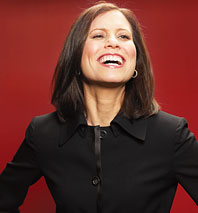
Even from a corner office on the seventeenth floor, there’s not a lot of blue sky visible from the Condé Nast building. You mostly look at a rather grim crowd of older, taller office buildings. But blue sky is all Joanne Lipman says she’s been seeing for the twenty months that the new business magazine she’s editing, Portfolio, has been gestating. It’s due on the newsstands next week. With a reported budget of $125 million, it’s the most expensive launch Condé Nast has ever done. And given the trend of advertising moving from print to the Web, it’s possibly the last brand-new, big-time journalistically ambitious magazine ever. She’s promising something original, something worthy of the inventor of the Wall Street Journal’s profitable, colorful consumer-lifestyle sections. “Everything I’ve ever done, anything I’ve ever worked on creating, I always start by not comparing,” she says. “If you’re comparing, then you’re just repeating. The entire reason to do this magazine is to ask, If you’re starting business coverage right now, in 2007, how do you do it? That’s the whole fun of it. It’s blue sky.”
But given the dark cloud over the industry right now, a lot of her competitors are hoping that Lipman will fail—the Schadenfreude Squad, Portfolio deputy editor Amy Stevens, who’s also from the Journal, calls them. Sour journalists rooting for a fall from grace. Between the magazine’s frenzy of big-ticket hiring (75 people, from places like the Times, the Journal, Time, and Vanity Fair) and her reputation as being, as Stevens delicately puts it, “exacting,” there’s a lot of resentment out there. How could Condé Nast do this now? Just who does Lipman think she is?
In 2004, Condé Nast tested two magazines: an art-and-culture project proposed by then–editorial director James Truman and a lush yet manly business magazine that the suits at the company thought was a good idea. And, according to the company’s chairman, Si Newhouse, the data “showed that there was the potential for a magazine that covered business intelligently in a style we were ready to bring to the table.” Truman’s idea apparently didn’t do as well, and by January 2005, he quit the company. Lipman had lunch with Newhouse in June and was hired by August.
“Portfolio’s an important position to take. It’s an important launch,” says Newhouse, who agreed to be interviewed because, given the negativity of the industry right now, talking about it “just seemed like the right thing to do.” Even the aloof billionaire has to pitch in to sell this thing.
Portfolio promises to be different enough from its rivals—Fortune, Forbes, Business 2.0, Fast Company—to sell ads when they can’t seem to anymore. But according to its publisher, David Carey, whose career credits include running the business side of The New Yorker, SmartMoney, and, earlier this decade, an ill-fated combination of Fast Company and Inc., the slide of Portfolio’s competitors represents an opportunity. He rattles off a list of brands—Microsoft Xbox, InStyle, Fox News—that thrived in supposedly saturated markets. And Condé Nast does pull off upsets: Two-year-old Teen Vogue sells more ads than its competitors by appealing to the children of the affluent (think the popular girls from Heathers), who are more interested in pricey fashion than in relationship advice. Portfolio’s supposed to appeal to their dads. The premiere issue promised ad buyers an average reader who’s a wealthy, 42-year-old male, and claimed there’s a 30 percent chance he’s a “C-suite” executive (i.e., CFO, CEO, or COO).
Before she was hired by Newhouse, partly at the suggestion of Truman’s replacement, her longtime occasional lunch buddy Tom Wallace, Lipman, who’s 45, had worked only at the Journal. She’d quickly risen through the ranks from reporter to columnist to editor. The “Weekend Journal,” which started in March 1998 and helped float the rest of the paper during the post-dot-com-boom downturn, was her baby, too. “For a year and a half before that, I was, like, closeted in a room with Joe Dizney, who became the Journal’s design director,” she says. “Just kind of imagining what this thing would be, then assigning stories and finding writers. Just blue sky.” Lipman does not want for confidence. “Every single thing we were doing was completely brand-new … I reinvented the wheel.” “Weekend” begat the “Personal Journal” section and, finally, the paper’s Saturday edition, which she was overseeing when Newhouse called (even while admitting that he read her sections “less thoroughly than the business part” of the Journal).
But now blue-sky time is over. It’s time to see if she’s reinvented the wheel again. The bloggers have been hired for the Website, which Condé Nast emphasizes is only in “beta.” Really, its line seems to be, the whole magazine is in beta. “Launches involve a considerable amount of risk. It’s something to get excited about,” Newhouse says. “The outlook is favorable, but life is a gamble.”
And Lipman will find out if Newhouse means it when he says, “There’s not, in our thinking, a time limit on it. We’re going to make it work.”
Have good intel? Send tips to intel@nymag.com.